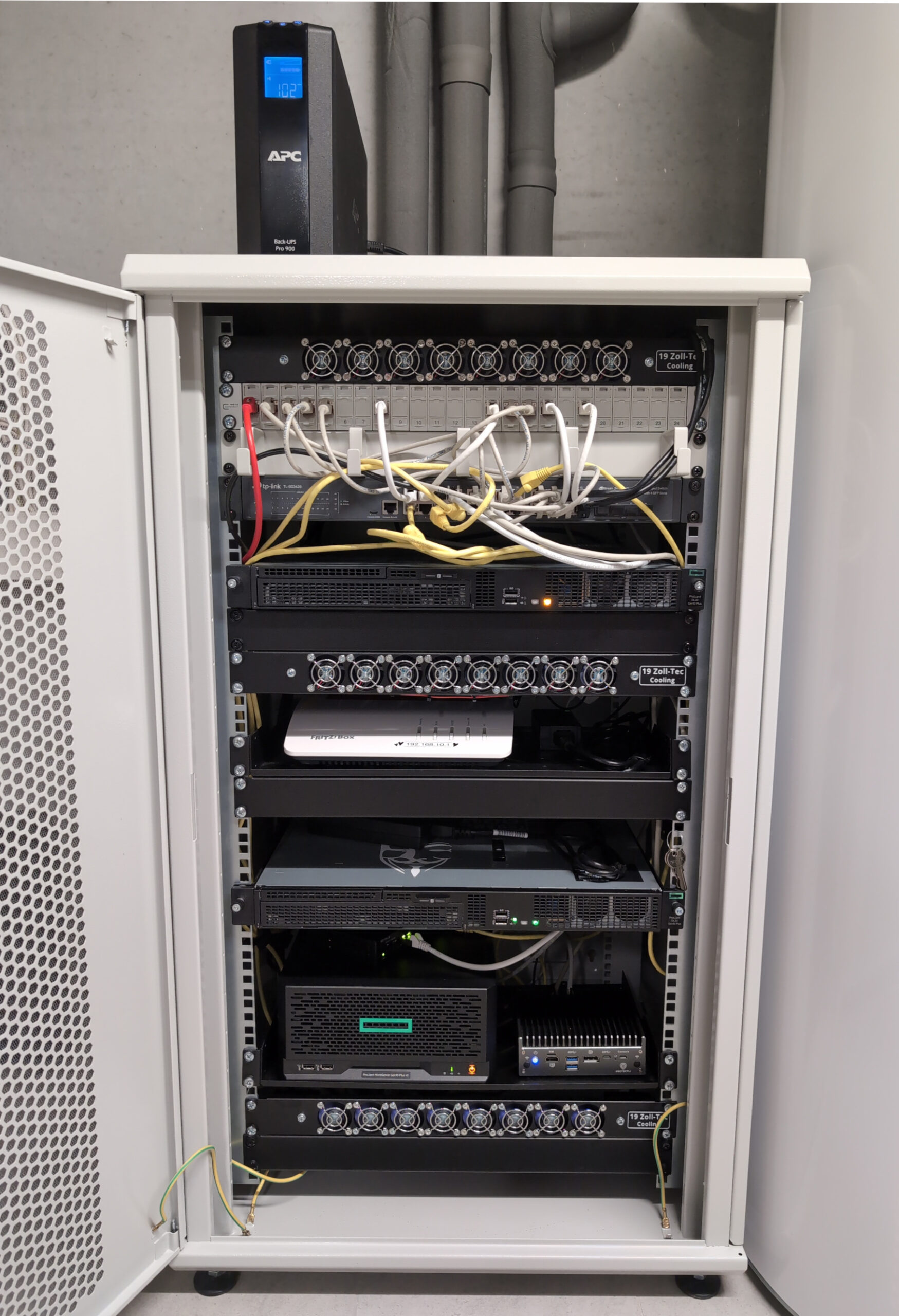Over the last bunch of years, I’ve built up a ton of important files — mostly family photos, including some of people who sadly aren’t around anymore. Losing any of that just isn’t an option. And since we use multiple PCs, laptops, media players and more around the house — and I care a lot about regular backups — I decided to set up a central, always-on local storage system.
There’s a lot of personal and valuable data involved, and I’m not too keen on handing it over to big cloud giants — especially not with whatever chaos happens to be coming out of the US this week. So yeah, a self-hosted NAS (Network Attached Storage) running on open-source was a no-brainer. 😄
What’s in the Rack (Down in the Basement)
I’ve got everything set up in a small 19″ rack. Here’s what’s currently in there:
- 1x Fritzbox 7590AX – connects to the internet via fiber (Telekom)
- 1x TP-Link TL-SG3428 – 24-port managed switch
- 2x HP DL20 Gen10 Plus servers
- 1x HP MicroServer Gen10 v2
- 1x Patch panel – connects all the LAN ports from every room
- 1x APC UPS – for battery backup
- 1x Protectli VP2420 – firewall appliance
Both HP DL20s are running Proxmox as hypervisors. Each one has a fast SSD for the OS and a classic HDD for storing actual data.
File Sharing, Backups & Network Stuff
On the main server, I’ve got a Samba VM that shares out all my files over CIFS. That way, I can access everything from different clients—PCs, laptops, even media players. I’m using CIFS instead of NFS right now just to keep things compatible across Linux, Windows, and macOS.
Still deciding what to do with the second HP server—either I’ll split internal/external stuff (like a DMZ setup), or maybe I’ll just turn it into a test environment.
The third server is running Proxmox Backup Server. It handles regular backups of all the VMs.
On top of that, I occasionally clone my data to an external USB drive, and I’ve got another one stored off-site in case something like a fire or flood ever hits the basement. Gotta follow the 3-2-1 backup rule, right?
All the servers have two NICs—one for internal traffic, one for the external/DMZ zone.
VPN to Mom’s Place
There’s a secure WireGuard VPN tunnel from my Fritzbox to my mom’s PC at her place in another city. She’s got WireGuard installed directly on her system. We used to do router-to-router VPN, but after her ISP changed, I switched her to client-based WireGuard. I was surprised at how quickly such an encrypted connection could be set up over the internet. On my Fritzbox, a setup wizard guided me through the installation and generated a config file for the client tunnel endpoint. I just had to deploy that file on my mom’s PC and activate the tunnel. The connection is automatically re-established every time Windows reboots. Her machine now gets an IP address from my local network, just like it was plugged in right here at home.”
Now, Robocopy takes care of regularly syncing her data back to my server—no more manual backups with USB drives (which honestly used to happen super irregularly, if at all).
Cooling & Power
The rack has a perforated front door for airflow, but I also added a mesh insect screen because the server LEDs were attracting bugs 😅. The fans are always pulling in air, so that helped.
Up top, I recently added exhaust fans to push hot air out. On really hot summer days, I’ll just open the rack door wide—works like a charm.
Extra VMs & Services
Besides just being a NAS, my setup runs a bunch of other VMs in the homelab. Right now, I’ve got:
- Jellyfin for media streaming
- GitLab for code hosting and CI
- Grafana for monitoring
- Nextcloud for file sharing and sync
- WordPress for this blog and a bit of light hosting here and there
I’m also using Icinga2 to monitor everything. It shoots me an email if a VM or service goes down—Nextcloud, the VPN, solar system, APs, internet connection, you name it.
To-Do: UPS Auto Shutdown
One thing I still need to finish: having the UPS automatically shut down the servers when it detects a power outage. Right now, it’s not fully set up yet, but I’m working on it.
OS Preferences
I usually run Debian 12 or Ubuntu on my clients. I only use Windows where I absolutely have to—like for Adobe Lightroom, since I haven’t found a solid open-source alternative for editing RAW photos from my DSLR.
Guest Wi-Fi
I’ve got a separate guest Wi-Fi network for friends and family — and the occasional plumber or electrician who needs internet access. 🔧📶. It’s completely isolated from my internal network.
Who knows if they actually install updates or if their phones and tablets are just Wi-Fi-enabled malware farms causing chaos ? 😅
That’s why I keep them in a separate, isolated network. Just in case. 😉
Updates & Security
As an IT guy, I’m all about keeping things updated—fixing bugs, patching security holes, and all that good stuff.
From the Cloud to the Basement: Should I Self-Host Our Church Group’s Nextcloud?
I’m currently running a Nextcloud instance on a rented internet server for a local church group here in town. It’s been working well, reliable, no major headaches — and that’s been the case for years now. But as my homelab keeps growing (faster than my need for sleep), I’ve been thinking: Why not just run it myself? I’ve got more server resources at home than I know what to do with — I’d mine Bitcoin, but my GPU would probably just catch fire. So instead, I put the hardware to actual good use. 😄
So here’s the (possibly brilliant) idea: I’d migrate the entire setup to my homelab and, as always, automate the heck out of it with Ansible. Nothing beats spinning up a fully working Nextcloud stack with one command and a fresh cup of coffee.
But I’m not just doing this for fun (okay, maybe a little). The instance is seeing a lot of active use lately, and it’s no longer just a side project. It’s become a core tool for the group’s collaboration — document sharing, calendar syncing. And with that comes a bit of pressure: I know what it would mean to host this thing myself.
Of course, there are concerns — let’s be honest. Hardware-wise, I’m totally covered. CPU, RAM, storage? Check, check, and check. The only real concern is my internet connection – because if that goes down for an extended period (say, one wrong move with a neighbor’s excavator) – boom: no Nextcloud for anyone.
Still, I figure: with proper backups and a clean rollback strategy, even if my home setup went offline, switching back to a rented server shouldn’t be too painful. It’s not a decision I’ll rush, but it’s definitely something I’m seriously considering.
To wrap things up: Self-hosting always sounds fun in theory — and often is fun in practice — but when others depend on the service, things change. Still, with the right prep and automation in place, it could be a solid move.
I think this is going to turn into a personal project that’ll keep me busy in the evenings for a while — and probably lead to a few more posts along the way. 😊
If you know of any meaningful or volunteer-driven project that could use some homelab housing — just give me a shout! Always happy to put some rack space to good use 🙂
TL;DR
I’ve built a fully self-hosted, open-source homelab setup to keep my growing pile of important data safe — from family photos to (maybe on day) church group files. It’s running 24/7 in a rack in the basement, backed by Proxmox, backups, solar power, and a touch of paranoia 😳 (hello, off-site drives and VPN to mom’s house!). I ditched big cloud providers in favor of full control, automation with Ansible, and digital freedom of mind – and the chance to give something back — through tech and infrastructure, the way I know best. With Nextcloud, Samba shares, media streaming, and more VMs than I need, it’s basically my own personal data center — bugs on the mesh screen included.
And why am I doing all this? Simple answer: because I can 😄🙈😄 — and because I learn a ton along the way, which ties in perfectly with what I do professionally. I work in IT, dealing with GNU/Linux, monitoring, cyber security, and automation on a daily basis — basically living on a never-ending treadmill of configs, scripts, and fixes. Plus, with solar panels on the roof, I’m practically drowning in electricity these days — might as well put it to good use! 😄
If you wanna know more or dive deeper into any of this — just hit me up!

